|
Occasional nosebleeds are very common. The nasal lining is rich in tiny blood vessels, very fragile and sensitive, when the air is too dry or if you pick or blow your nose vigorously, nosebleeds can easily result. Nosebleeds are a nuisance but are usually not a sign of a serious medical condition. Common nosebleeds can be handled at home:
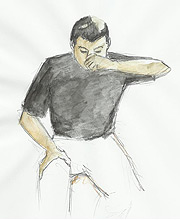 |
Proper posture to stop nosebleeds |
 |
Sit upright and lead forward, and breathe through your mouth; |
 |
Blow your nose to clear out any blood clot, and pack it with cotton or gauze; |
 |
Squeeze shut the soft part of the nose for 10 minutes; |
 |
If the bleeding does not stop, apply fresh packing and pressure for another 10 minutes. |
Remember that the ruptured blood vessel needs 7 to 10 days to heal completely, do not pick your nose or knock the scab off during this period. The following tips help prevent the nose from bleeding again:
 |
Humidify your home or sleeping room |
 |
Avoid lifting or straining |
 |
Elevate the head on one or two pillows while sleeping |
 |
Apply lubricating ointment inside the nose |
 |
Do not take cold and allergy medicines, and drugs that thin the blood |
 |
Quit smoking and alcohol |
In case if you have frequent nosebleeds, or if the bleeding is heavy and hard to stop, you should call your doctor. Medical conditions that may cause nosebleeds include allergic rhinitis, sinusitis, infectious diseases, hypertension and bleeding disorders that need clinical examinations to differentiate.
If clinical examination rules out any physical cause for your nosebleeds, you may try Chinese medicine methods for relief.
In traditional Chinese medicine (TCM) understanding, nosebleeds are usually due to over-heated blood, and cooling herbs for this include couch grass rhizome, hairyvein agrimonia herb, common bletilla tuber and oriental arborvitae leafy-twig. Persistent or recurrent nosebleeds may indicate an internal disharmony has formed, and the source of heat should be eliminated. Physicians will consider the characteristics of the bleeding, including the duration, interval, amount of bleeding, color and texture of the blood, and the overall condition of the body when identifying a disharmony pattern.
 |
|
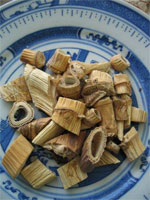 |
|
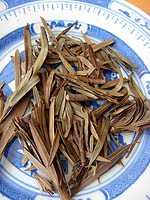 |
| baical skullcap root |
|
reed rhizome |
|
oriental arborvitae leafy-twig |
1. Herbal prescriptions for nosebleeds
Heat in lung meridian
Bright red nasal drippings, extreme dryness and a burning sensation in the nasal passages; individuals may also experience dry coughing, mouth dryness or a feverish sensation in the body. The tongue is red and covered with yellow coating, and the pulse is floating and rapid. This disharmony often occurs during the dry season or common cold. The remedy should aim to clear lung heat and cool blood.
Sample prescription: Mulberry Leaf and Chrysanthemum Decoction plus peony root bark, couch grass rhizome and oriental arborvitae leafy-twig.
Heat in stomach
Profuse nasal bleeding and the blood is bright red or dark red; individuals may also have dryness in the nasal passages, bad breath, mouth dryness, swollen gum, thirst, constipation and scanty urination with a burning sensation. The tongue is red and covered by yellow coating, and the pulse is surge and rapid. People who over-consumed greasy and spicy foods or alcohol tend to develop this kind of disharmony. The remedy should aim to clear stomach heat and cool blood.
Sample prescription: Jade Woman Decoction plus reed rhizome, oriental arborvitae leafy-twig and couch grass rhizome
Heat in liver
Profuse nasal bleeding and the blood is deep red; individuals may also have headache, blurred vision, a bitter taste in the mouth or mouth dryness, a red face, bloodshot eyes, irritability, and discomfort in the rib sides. The tongue is red and covered by yellow coating, the pulse is taut and rapid. This disharmony tends to occur in hypertensive individuals. The remedy should aim to clear liver heat and cool blood.
Sample prescription: Gentian Liver-Purging Decoction plus reed rhizome, oriental arborvitae leafy-twig and Indian madder root
Heat in kidney and liver
Intermittent and mild nosebleeds; individuals may also have mouth dryness, dizziness, blurred vision, ear ringing, palpitations, insomnia, warm palms and soles. The tongue may look deep red or tender and is covered by little coating, and the pulse is thready and rapid. This disharmony tends to occur in those who are in an exhausted state or with chronic conditions. The remedy should aim to nourish liver and kidneys, and cool blood.
Sample prescription: Six-ingredient Rehmannia Pill plus anemarrhena rhizome, Amur corktree bark, red peony root, peony root bark and couch grass rhizome
Spleen deficiency
The bleeding is persistent but mild, there may also have gum bleeding or bleeding under the skin, paleness, breath shortness, poor appetite, dizziness, loose bowels and fatigue. The tongue is pale and the pulse is weak. This disharmony can be seen in people recovering from major illnesses or those who have system bleeding disorders. The remedy should aim to invigorate spleen, replenish qi (vital energy) and reinforce its ability to astringent blood.
Sample prescription: Restore the Spleen Decoction plus lotus rhizome node, hairyvein agrimonia herb and schizonepeta herb (charred)
Nosebleeds and menstruation:For some females, their nosebleeds occur periodically with menstruations, or follow the hormonal fluctuations of the body. TCM believes that the symptom is mainly due to over-heated blood or reverse qi flow in the thoroughfare vessel meridian that forces the blood flowing out of the normal pathways. Individuals are usually accompanied with a decreased menstrual flow or missed periods. The common disharmony patterns are:
Liver stagnation generating fire
Nosebleeds before or during periods, the bleeding is quite heavy and bright red colored. Individuals may also have short periods with a decreased menstrual flow or missed periods, irritability, discomfort in the rid sides, mouth dryness or a bitter taste in the mouth, yellowish urine and constipation. A red tongue with yellow coating, the pulse is taut and rapid. The remedy should aim to soothe liver, clear heat, and induce blood flowing downward.
Sample prescription: Clear Liver and Regulate Menstruation Decoction
Yin deficiencies of kidneys and lungs
Nosebleeds before or during periods, the bleeding is scanty and darkish red colored. Individuals may also have short periods with a decreased menstrual flow, dizziness, ear ringing, warm palms and soles, red cheeks, hot flushes, coughing and mouth dryness. The tongue is red and with little coating, the pulse is thready and rapid. The remedy should aim to nourish kidneys and lungs, and induce blood flowing downward.
Sample prescription: Smooth Menstruation Decoction
2. Acupuncture for nosebleeds
Acupuncture therapy is generally not indicated for bleeding symptoms, however, if the underlying cause of nosebleed is not due to a blood-clotting problem, acupuncture can have some effects. In TCM, nosebleeds are often resulted from excessive heat in the upper body, and somehow nosebleed is regarded as a way of draining away the heat by the body. Acupuncture can promote the body to eliminate the heat by working on appropriate body points and techniques. During operation, blood letting method may be used, that physicians use a needle to prick on a specific body point and squeeze gently to release 4-5 drops of blood. Acupuncture prescriptions for nosebleeds are aimed to clear heat from the targeted organs and meridians.
Disharmony patterns |
Suggested body points |
Stimulation techniques |
Lung heat |
shao shang (Lu 11), ying xiang (Li 20), feng chi (Gb 20), he gu (Li 4) & kong zui (Lu 6) |
Reducing techniques, and bleed letting on shao shang (Lu 11) & ying xiang (Li 20) |
Stomach heat |
nei ting (St44), er jian (Li2), ju liao (St3), shang xing (Gv23) & tian shu (St25) |
Reducing techniques, and bleed letting on ju liao (St3) & shang xing (Gv23) |
Yin deficiency leading to virtual fire (kidney and liver heat) |
tai xi (Ki3), tai chong (Lr3), san yin jiao (Sp6), su liao (Gv25) & tong tian (Bl7) |
Even techniques |
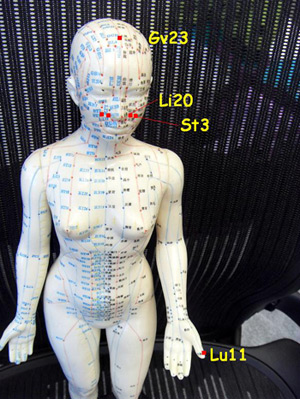 |
Blood letting points for nosebleeds |
3. Home remedies for nosebleeds
Most nosebleeds can be managed at home, and many self-care methods are available. Below are TCM recommendations that are suitable for those who get frequent nosebleeds.
Remedies |
Methods |
Topical herbal applications (promote local clotting of blood and stop bleeding) |
Suggested stop-bleeding ingredients are notoginseng, puffball, common bletilla tuber, carbonized hair and natural indigo. Select one of the ingredients, grind into powder and put aside. Each time, take some powder with a cotton tip, and then insert into the bleeding nose and press for 10 to 30 minutes. A proprietary Chinese medicine called yun nan bai yao can also be used. |
Ice pack |
Apply an ice pack to the forehead, bridge of the nose or neck can help the blood vessels to constrict. |
Foot remedies (induce blood flowing downward and relieve stagnation in the upper body) |
 |
Soak the feet in warm water for 20 minutes first, crush a clove of garlic and paste on the centre of the feet (Ki1), keep it in place for four to six hours. Paste on the left foot, if the bleeding comes from right nostril; paste on the right foot, if the bleeding comes from left nostril; paste on both feet if the bleeding comes from both nostrils. |
 |
Prepare rehmannia root (24g), figwort root (30g), white mulberry root-bark (25g) and achyranthes root (15g), boil with 3000ml water, and use the solution to soak the feet. |
|
 |
|
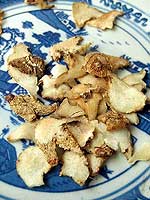 |
|
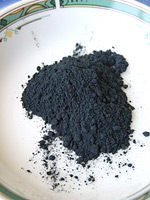 |
| puffball |
|
common bletilla tuber |
|
natural indigo |
4. Home care advice for nosebleeds
For those who have a tendency to get nosebleeds, a healthy lifestyle should be maintained. Staying up all night, drinking alcohol and smoking or mental stress can easily trigger another nosebleed. It is recommended to avoid hot spicy foods, and eat more cooling foods such as Chinese cabbage, lotus root, tomato, loquat fruit, water chestnut, Chinese radish, pears and eggplant. Some food recipes are suitable to take regularly:
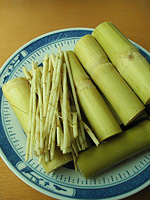 |
Fresh couch grass rhizome
and sugar cane |
 |
Fresh lotus root juice 100-150ml, and add 15-30g of honey. |
 |
Mulberry leaf (3g) and couch grass rhizome (60g) and liquorice root (5g); prepare as tea and drink regularly. |
 |
Couch grass rhizome (60g) and sugar cane (300g); boil with 1000ml water and drink regularly. |
 |
Black soybeans (50g), longan aril (15g) and red dates (50g); boil with 800ml water for 30 minutes, eat in the morning and night. This is especially for those with chronic health problems. |
 |
Yerbadetajo herb (15g) and red dates (8-10 pieces); boil with 500ml water for 20 minutes. This tea is especially for those with chronic health problems. |
 |
Red dates and pig’s feet stew: Prepare red dates (500g), pig’s feet (600g), fourleaf ladybell root (30g) and wolfberry (20g). Wash the ingredients, and chop the pig’s feet into pieces. Put all the ingredients in a pot with 1000ml water, bring to a boil quickly, add in salt, millet wine, ginger, pepper to taste; return to simmer and stew until the meat is fully tender. Eat this stew five days before period. It is suitable for nosebleeds during menstruation that have lung and kidney dysfunctions. |
 |
Prepare lily bulb (30g), fragrant Solomonseal rhizome (15g) and common bletilla tuber (3g, powdered) and one egg (poached and peeled). Boil the first two herbs in 500ml of water for 30 minutes, then discard the herbs and add in the egg and herbal powder, stir evenly, add sugar to taste and serve warm. Drink the tea and eat the egg. It is suitable for nosebleeds during menstruation that have lung and kidney dysfunctions. |
 |
Lily flowers (30g, dried), couch grass rhizome (30g), selfheal fruit spike (10g) and water chestnut (30g). Wash the ingredients, cut or peel into proper sizes. Put all the ingredients in a pot with 1000ml water, boil for 30 minutes, add sugar to taste and serve warm. It is suitable for nosebleeds during menstruation that have liver dysfunction. |
|